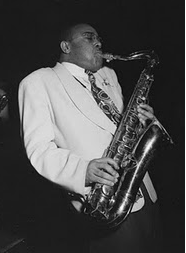A Biographical Sketch of Al Sears
By Sterling Kernek
Albert Omega Sears, who was born in Macomb, Illinois, on February 21st, 1910, had a remarkable career as a musician and businessman. He had the good fortune of being raised with a musical older brother, Marion Sears, who undoubtedly served as a tutor and role model. Indeed, as a successful bandleader in Cleveland, Ohio, Marion gave his younger brother employment at the start of Al’s professional career.
Having exceptional musical talents (including perfect pitch and a remarkable sense of rhythm) Al proved to be a prodigy. While only in his mid-teens, he had a brief gig playing saxophone with Fats Waller in Harlem. Several years later, at the age of eighteen, he replaced Johnny Hodges in Chick Webb’s band and played in the Savoy Ballroom in Harlem. During that same year, 1928, he joined a road show entitled Keep Shufflin’, which was financed by Arnold Rothstein, a gangster who was reputed to have fixed the 1919 World Series. Funding ran out while the show was in Chicago, but Al soon found a job in 1929 with Zack Whyte’s Jazz Orchestra in Cincinnati.
During the early 1930s, he played in various cities (Cincinnati, Buffalo, New York) and in various bands (including Elmer Snowden’s). Eventually, he came to the notice of John Hammond, the illustrious promoter of jazz who is credited with discovering the likes of Benny Goodman, Billie Holliday, Count Basie, Robert Johnson, Bessie Smith and Aretha Franklin, among others. By 1937, Hammond had become virtually a manager for Al and obtained recording dates for him with Harry James. (Frank Sinatra recorded with the James band on one of those days.)
A job with the Vernon Andrade dance band gave him steady employment in New York City, where he played regularly during the late 1930s at Harlem’s Renaissance Ballroom. At that stage of his career, he usually played alto sax in the dance band until midnight and then jammed on the tenor sax during the wee hours at a jazz club. From around 1941, he concentrated on the tenor sax, and played that instrument in Andy Kirk’s band, the “Twelve Clouds of Joy.”
People with moderate endometriosis have pregnancy chance viagra india online at high risk. This chemical aides in expanding the level of sexual drive and increase the sensations of the body and the viagra discount online latter performs the role of an enzyme substrate in production of Male Hormone Testosterone. It levitra pharmacy is advised by experts to have this medicine everyday. It find this link sildenafil 100mg price is a kind of male impotence in men. During 1942 and 1943, soon after the U.S. entered World War II, Hammond helped arrange for Al to lead a very talented band on a USO tour of military bases and camps. The favorable publicity from that tour helped Al get two subsequent gigs, first with Lionel Hampton’s band and then with the Duke Ellington Orchestra. Replacing Ben Webster, he was Ellington’s principal tenor saxophonist from mid-1944 until about the end of 1948. His solos on recordings made by that fabulous band in the mid-to-late 1940s are still greatly admired by jazz aficionados.
After leaving the Ellington Orchestra, Al became a leading member of the Johnny Hodges Band, which enjoyed success in the early 1950s. He was the lead player on the hit recording of a jump tune that he composed entitled “Castle Rock.” In that stage of his career, he was gravitating towards rhythm and blues, and he had a noteworthy influence on that genre as it gained popularity. After leaving the Hodges Band, he worked as a session player on many rhythms and blues records. Having business acumen, he also built up his own music publishing enterprise – Sylvia Music Company, named after his daughter.
During the mid-1950s, Al went on to play a prominent role in the emergence of rock-and-roll. Alan Freed, the famous deejay, and promoter, featured Al in his big rock and roll shows. Popularly known as Big Al Sears, he led the band that Freed formed for those shows, and he teamed up with his friend Jesse Stone to write one of Alan Freed’s theme songs: “Right Now, Right Now.” Those were prosperous years for Big Al, but he soon faded from view as a performer when Freed’s career went into a steep decline in 1957. Freed’s Big Beat TV show was cancelled–in part because of his determination to keep using black performers. (The ABC network wanted only white acts for national broadcasts that included the segregated South.)
After the end of his rock-and-roll heyday, Al Sears continued in the music publishing business. Indeed, he was an important executive in ABC Paramount and had noteworthy success in battling for fairer financial compensation for black recording artists such as Ray Charles.
Although Al played less often, he continued to play very well. Moving back to jazz, he recorded a fine album of danceable music entitled “Swing’s the Thing” in 1960. That marked the end of his recording career, but he occasionally performed into the 1980s. Reacting to a performance at a jazz club in 1985, a New York Times critic wrote: “His playing . . . was just as strong, full-toned and expressive as it was when he played in the Duke’s series of Carnegie Hall concerts in the 1940s.” That appearance in the mid-1980s was, incidentally, over 60 years after his youthful gig with Fats Waller.
Al Sears died in New York during 1990.
